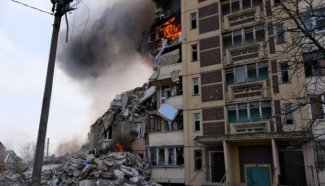The battle for Avdiivka enters its third month. Day 656 of the war

On 10 December General Oleksandr Syrskyi, the commander of the Ukrainian Land Forces, described the situation in the combat zones as difficult. He emphasised that Russian troops were storming the defenders’ positions along the entire front. He considered the main tasks of the Ukrainian forces were to ensure the sustainability of the defence, protect soldiers’ lives and use ammunition in a rational way. Two days later General Oleksandr Tarnavskyi, the commander of the Ukrainian Tavria operational-strategic group of troops, announced that on 10 December the invaders had launched massive offensive operations towards Avdiivka and Marinka. On that day, a record 49 hostile attacks were launched in the Avdiivka area, and 42 were recorded on 11 December, representing half of the total number of Russian assaults on the defenders’ positions across the entire front.
The Russians have probably broken through the existing Ukrainian defence line in the southern part of Avdiivka and entered the built-up part of the town. They have also made progress on its northern outskirts, in the area of the coke and chemical plant. The invading forces have also advanced in Marinka itself and south of the town. The area under Ukrainian control covers several areas on the western outskirts of the city, and is estimated at just 3% of its total area. The invaders resumed their offensive operations towards Siversk, between Bakhmut and Kreminna, and achieved slight success in the southern section of the arc controlled by the Ukrainians (in the area of the village of Vesele). They also made further minor advances west of Bakhmut and south of Orikhiv in Zaporizhzhia oblast, where Ukrainian troops also attempted to advance. In contrast, the defenders managed to stabilise the situation west of Kreminna and north-east of Kupyansk, where committed reserves held off a series of enemy assaults. According to the Ukrainian General Staff, the invaders also launched an unsuccessful attack in the vicinity of Vuhledar. The situation in Krynky on the left bank of the Dnieper remains unchanged: the Ukrainians still control the central part of the village.
On the night of 12 December, the Russians launched another kamikaze drone attack on Odesa oblast, where civilian infrastructure was reportedly damaged. According to a report from the Ukrainian Air Force Command, 15 Shahed-136/131 drones were used, nine of which the defenders shot down. The day before, the Command had announced that all 18 Shaheds attacking the south of the country had been shot down, as well as all eight missiles heading for Kyiv (their type was not specified: Command spokesman Colonel Yuri Ihnat said they could have been Iskander-M ballistic missiles or missiles from S-400 systems). Authorities in the capital reported minor damage to buildings as a result of falling shrapnel, and said that four people were injured. Later, the Ukrainian Ministry of Energy reported that the impacts had damaged the energy infrastructure in the Darnytskyi district of the city, which temporarily cut off power supply to some consumers. In addition, on 11 December Russian missiles were said to have attacked Kryvyi Rih twice (from where explosions were reported), as well as the city of Dnipro (its defenders claimed to have shot down two Kh-59 rockets). Enemy missiles also hit Kryvyi Rih (an industrial plant was damaged) the day before, Velykyi Burluk in Kharkiv oblast on 9 December, and Mykolaiv on the evening of 8 December (areas near the town were hit). During the period in question, the invaders used a total of 17 missiles of various types.
On 11 December, the UK Ministry of Defence announced that a naval coalition had been formed under the aegis of Oslo and London to provide long-term support to Ukraine. This will include the supply of equipment to the navy there, the development of its capabilities (naval infantry and patrol units in internal and coastal waters were mentioned specifically), training programmes, and infrastructure development. UK Defence Minister Grant Shapps confirmed the transfer of two Sandown-type minehunters to Kyiv. This information may be misleading as it actually refers to the Chernihiv and Cherkasy ships (formerly the HMS Grimsby and the HMS Shoreham) which the Ukrainian Navy took delivery of in July this year. As announced by Ukraine’s defence ministry, the first donation from the UK and Norway as part of the coalition is expected to be 20 BvS 10 Viking tracked articulated amphibious armoured vehicles and 23 fast motorboats. On the same day, during a visit to Washington, President Volodymyr Zelensky met representatives of the US arms industry, whom he urged to cooperate in the production of munitions and air defence systems. Representatives of the US government declared that the US would provide Ukraine with one more package of military aid by the end of the year.
The ČTK news agency reported on 12 December that, as of February 2022, the Czech government had issued licences for the supply of arms and military equipment to Ukraine totalling 117 billion Czech crowns ($5.16 billion). The value of the contracts completed to date was 51.2 billion crowns ($2.26 billion).
On 10 December, the Bundeswehr’s inspector general Carsten Breuer announced that Germany would be able to supply Kyiv with 200,000 artillery shells in 2024. Two days earlier, Berlin announced that as part of a new support package the Ukrainian army had received supplies including 10 Vector reconnaissance drones, a Luna NG reconnaissance system (consisting of several ultralight drones and a ground control station), 70 HK GMG/GMW automatic grenade launchers, 250 rounds of 155-mm ammunition, and eight Zetros trucks. Also on 8 December, Bulgaria’s parliament rejected a presidential veto of an agreement with Ukraine which will allow it to hand over military aid including 100 BTR-60 armoured personnel carriers withdrawn from service with the Bulgarian interior ministry.
The press service of the Ukrainian 3rd Assault Brigade reported on 11 December that the unit had been relieved a few days ago and had gone to the rear to replenish losses and reorganise. It had been fighting on a section of the frontline south of Bakhmut for the past year without a break. In the first months of 2023, it repulsed attacks by Wagner Group assault troops, and in May it switched to the offensive, driving the Russians back to the Bakhmut-Horlivka railway line and retaking an area of about 20 km².
On 11 December, the Financial Times published an article on President Zelensky's communication strategy. The British newspaper claims that he is basing his message on the slogan of ‘Going forward’ and – regardless of the circumstances – is not reporting any bad news, such as Ukrainian losses or Russian successes on the battlefield. This approach could result in a form of self-censorship in the work of government institutions and the army. According to the article’s interlocutors, the gap between official communiqués and the actual situation on the front is undermining confidence in the central authorities and reducing the motivation for the war effort of both the Ukrainian public and Kyiv’s Western partners.
On 8 December Finland's Supreme Court rejected Ukraine's request for the extradition of the Russian war criminal Jan Piotrovsky (a.k.a. Voislav Torden); it also ordered his release from the prison where he had been held since this summer. The decision was justified on grounds of concern about human rights violations in Ukrainian prisons. On 11 December, the lower court again ordered Piotrovsky to be detained at the request of the Finnish border guard service. He has been linked to Russian neo-Nazi and neo-pagan movements for years, and was also charged with committing war crimes against Ukrainian POWs in 2014. In 2022 Piotrovsky acted as one of the commanders of the Rusich mercenary unit, and called for surrendering Ukrainians to be murder. In July this year he left Russia for Finland, for reasons which remain unclear.
Commentary
- Irrespective of the optimism officially presented by the government in Kyiv, the command of the Ukrainian army seems fully aware that without rapid and significant reinforcements, it will probably be necessary to abandon some of the positions currently being held and build new lines of defence. Ukraine has exhausted both the forces and means to conduct larger-scale offensive operations comparable to the summer offensive in the south. The number of counter-attacks undertaken by the defenders is diminishing, and these are aimed solely at local containment or slowing down the invaders’ advance. Looking ahead to the next few weeks, the army will most likely move to conducting static defence along the entire line of contact, and to entrust sections of it to units that are less experienced and have so far been less involved in the fighting, which will give the elite formations time to recover (the withdrawal of the 3rd Assault Brigade from the front is a demonstration of this approach). However, everything depends on what attitude the Russian adopt: they now have a much greater ability to rotate fighting units (which they can do on an ongoing basis) and do not need to take operational pauses. An eventual Russian breakthrough of the front, coupled with attempts to develop such a success, may force the Ukrainian command to reintegrate some units into the fighting before they regain combat capability.
- The 3rd Assault Brigade is an example of the implementation of unconventional and effective organisational and training solutions in the Ukrainian army. The unit did not exist before the Russian invasion: it originated from a group of volunteers from the first weeks of the war. It was developed to brigade size at the end of 2022, and the core of its officer and non-commissioned officer cadre is made up of people from the Azov group. The unit has organised its own recruitment service, and has been running an extensive media campaign to attract volunteers from among the civilian population and other military units. Currently, the unit is one of the best and largest brigades in the army, and service in it brings high prestige, so the formation has not been suffering any personnel problems. The solutions applied by the brigade, some of which stand in stark contrast to the rigid and inefficient structures of the professional army, are an example of the construction of a new kind of military formation; they also offer a model of how to overcome the organisational and personnel crises currently facing the Ukrainian army.





